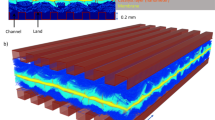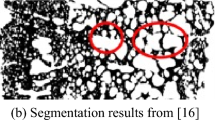Abstract
X-ray computed tomography (CT) is increasingly used to characterize the morphology of water distribution in gas diffusion layers (GDLs) for polymer electrolyte fuel cell (PEFC) applications. The resulting images can provide access to critical performance data for GDLs, including internal water contact angle distributions, water saturation, water cluster size, and pore-size distributions. Given the propensity for unimodal grayscale pixel distributions in X-ray CT images, basic image processing techniques like thresholding, erosion, and dilation are often insufficient. To address this issue, we used machine learning algorithms to segment X-ray CT image stacks of GDLs, comparing the performance of basic image processing with decision tree learning (via Trainable WEKA Segmentation) and convolutional neural networks (CNNs) (via U-Net and MSDNet). The training methods and classification features for each algorithm were varied and evaluated against a GDL sample with a semi-bimodal pixel distribution (SGL 10BA) and a more difficult, unimodal sample (EP40T). The optimal combinations for each algorithm were then applied to segment a GDL sample with a microporous layer (MPL), an SGL 10BC, as MPL-containing GDLs are generally preferred in PEFCs. We found that decision tree learning, aside from being the easiest to use, exhibited the best performance for each of the four phases—pores, water, GDL, and MPL—based on F1 scores. Based on the wide collection of literature, properly trained CNNs should produce significantly better results. However, obtaining such results may require substantially more investment to determine the optimal algorithm for a particular scenario.












Similar content being viewed by others
References
AlRatrout, A., Raeini, A.Q., Bijeljic, B., Blunt, M.J.: Automatic measurement of contact angle in pore-space images. Adv. Water Resour. 109, 158–169 (2017). https://doi.org/10.1016/j.advwatres.2017.07.018
AlRatrout, A., Blunt, M.J., Bijeljic, B.: Wettability in complex porous materials, the mixed-wet state, and its relationship to surface roughness. Proc. Natl. Acad. Sci. u.s.a. 115(36), 8901–8906 (2018). https://doi.org/10.1073/pnas.1803734115
Arganda-Carreras, I., Kaynig, V., Rueden, C., Eliceiri, K.W., Schindelin, J., Cardona, A., Sebastian Seung, H.: Trainable weka segmentation: a machine learning tool for microscopy pixel classification. Bioinformatics 33(15), 2424–2426 (2017). https://doi.org/10.1093/bioinformatics/btx180
Badrinarayanan, V., Kendall, A., Cipolla, R.: SegNet: a deep convolutional encoder-decoder architecture for image segmentation. IEEE Trans. Pattern Anal. Mach. Intell. 39(12), 2481–2495 (2017). https://doi.org/10.1109/TPAMI.2016.2644615
Bailey, J.J., Chen, J., Hack, J., Perez-Page, M., Holmes, S.M., Brett, D.J.L., Shearing, P.R.: Lab-based X-ray micro-computed tomography coupled with machine-learning segmentation to investigate phosphoric acid leaching in high-temperature polymer electrolyte fuel cells. J. Power Sources 509, 230347 (2021). https://doi.org/10.1016/j.jpowsour.2021.230347
Becker, J., Flückiger, R., Reum, M., Büchi, F.N., Marone, F., Stampanoni, M.: Determination of material properties of gas diffusion layers: experiments and simulations using phase contrast tomographic microscopy. J. Electrochem. Soc. 156(10), B1175 (2009). https://doi.org/10.1149/1.3176876
Berry, M.W., Mohamed, A., Yap, B.W.: Supervised and unsupervised learning for data science. Springer International Publishing, Cham (2020)
Breiman, L.: Random forests. Mach. Learn. 45(1), 5–32 (2001). https://doi.org/10.1023/A:1010933404324
Buechi, F.N., Flückiger, R., Tehlar, D., Marone, F., Stampanoni, M.: Determination of liquid water distribution in porous transport layers. ECS Trans. 16(2), 587–592 (2008). https://doi.org/10.1149/1.2981893
Eller, J., Rosén, T., Marone, F., Stampanoni, M., Wokaun, A., Büchi, F.N.: Progress in in situ X-ray tomographic microscopy of liquid water in gas diffusion layers of PEFC. J. Electrochem. Soc. 158(8), B963 (2011). https://doi.org/10.1149/1.3596556
Fishman, Z., Hinebaugh, J., Bazylak, A.: Microscale tomography investigations of heterogeneous porosity distributions of PEMFC GDLs. J. Electrochem. Soc. 157(11), B1643 (2010). https://doi.org/10.1149/1.3481443
Gostick, J.T., Ioannidis, M.A., Fowler, M.W., Pritzker, M.D.: Characterization of the capillary properties of gas diffusion media. In: Wang, C.-Y., Pasaogullari, U. (eds.) Modeling and Diagnostics of Polymer Electrolyte Fuel Cells, pp. 225–254. Springer New York, New York (2010). https://doi.org/10.1007/978-0-387-98068-3_7
Hall, M., Frank, E., Holmes, G., Pfahringer, B., Reutemann, P., Witten, I.H.: The WEKA data mining software: an update. SIGKDD Explor. Newsl. 11(1), 10–18 (2009). https://doi.org/10.1145/1656274.1656278
Hofmann, T.: Unsupervised learning by probabilistic latent semantic analysis. Mach. Learn. 42(1), 177–196 (2001)
Khajeh-Hosseini-Dalasm, N., Sasabe, T., Tokumasu, T., Pasaogullari, U.: Effects of polytetrafluoroethylene treatment and compression on gas diffusion layer microstructure using high-resolution X-ray computed tomography. J. Power Sources 266, 213–221 (2014). https://doi.org/10.1016/j.jpowsour.2014.05.004
Kim, S.-G., Lee, S.-J.: A Review on experimental evaluation of water management in a polymer electrolyte fuel cell using X-ray imaging technique. J. Power Sources 230, 101–108 (2013). https://doi.org/10.1016/j.jpowsour.2012.12.030
Kim, S., Mench, M.M.: Investigation of temperature-driven water transport in polymer electrolyte fuel cell: phase-change-induced flow. J. Electrochem. Soc. 156(3), B353 (2009). https://doi.org/10.1149/1.3046136
Kotsiantis, S.B., Zaharakis, I., Pintelas, P., et al.: Supervised machine learning: a review of classification techniques. Emerg. Artif. Intell. Appl. Comput. Eng. 160(1), 3–24 (2007)
Krüger, P., Markötter, H., Haußmann, J., Klages, M., Arlt, T., Banhart, J., Hartnig, C., Manke, I., Scholta, J.: Synchrotron X-Ray tomography for investigations of water distribution in polymer electrolyte membrane fuel cells. J. Power Sources 196(12), 5250–5255 (2011). https://doi.org/10.1016/j.jpowsour.2010.09.042
Kumbur, E.C., Mench, M.M.: FUEL CELLS – PROTON-EXCHANGE MEMBRANE FUEL CELLS | water management. In: Encyclopedia of Electrochemical Power Sources, pp. 828–847. Elsevier (2009). https://doi.org/10.1016/B978-044452745-5.00862-5
Liu, C.P., Saha, P., Huang, Y., Shimpalee, S., Satjaritanun, P., Zenyuk, I.V.: Measurement of contact angles at carbon fiber–water–air triple-phase boundaries inside gas diffusion layers using X-ray computed tomography. ACS Appl. Mater. Interfaces 13(17), 20002–20013 (2021). https://doi.org/10.1021/acsami.1c00849
Mehta, V., Cooper, J.S.: Review and analysis of PEM fuel cell design and manufacturing. J. Power Sources 114(1), 32–53 (2003). https://doi.org/10.1016/S0378-7753(02)00542-6
Ostadi, H., Rama, P., Liu, Y., Chen, R., Zhang, X.X., Jiang, K.: Influence of threshold variation on determining the properties of a polymer electrolyte fuel cell gas diffusion layer in X-ray nano-tomography. Chem. Eng. Sci. 65(6), 2213–2217 (2010). https://doi.org/10.1016/j.ces.2009.12.019
Otsu, N.: A threshold selection method from gray-level histograms. IEEE Trans. Syst. Man Cybern. 9(1), 62–66 (1979)
Pelt, D.M., Sethian, J.A.: A mixed-scale dense convolutional neural network for image analysis. Proc. Natl. Acad. Sci. 115(2), 254 (2018). https://doi.org/10.1073/pnas.1715832114
Quan, T.M., Hildebrand, D.G.C., Jeong, W.-K.: FusionNet: a deep fully residual convolutional neural network for image segmentation in connectomics. Front. Comput. Sci. 3, 34 (2021). https://doi.org/10.3389/fcomp.2021.613981
Rashapov, R.R., Unno, J., Gostick, J.T.: Characterization of PEMFC gas diffusion layer porosity. J. Electrochem. Soc. 162(6), F603–F612 (2015). https://doi.org/10.1149/2.0921506jes
Ronneberger, O., Fischer, P., Brox, T.: U-Net: convolutional networks for biomedical image segmentation. In: Navab, N., Hornegger, J., Wells, W.M., Frangi, A.F. (eds.) pp. 234–241. Springer International Publishing, Cham (2015)
Rosén, T., Eller, J., Kang, J., Prasianakis, N.I., Mantzaras, J., Büchi, F.N.: Saturation dependent effective transport properties of PEFC gas diffusion layers. J. Electrochem. Soc. 159(9), F536–F544 (2012). https://doi.org/10.1149/2.005209jes
Satjaritanun, P., Weidner, J.W., Hirano, S., Lu, Z., Khunatorn, Y., Ogawa, S., Litster, S.E., Shum, A.D., Zenyuk, I.V., Shimpalee, S.: Micro-scale analysis of liquid water breakthrough inside gas diffusion layer for PEMFC using X-ray computed tomography and lattice boltzmann method. J. Electrochem. Soc. 164(11), E3359–E3371 (2017). https://doi.org/10.1149/2.0391711jes
Shashank Kaira, C., Yang, X., De Andrade, V., De Carlo, F., Scullin, W., Gursoy, D., Chawla, N.: Automated correlative segmentation of large transmission X-ray microscopy (TXM) tomograms using deep learning. Mater. Charact. 142, 203–210 (2018). https://doi.org/10.1016/j.matchar.2018.05.053
Shelhamer, E., Long, J., Darrell, T.: Fully convolutional networks for semantic segmentation. IEEE Trans. Pattern Anal. Mach. Intell. 39(4), 640–651 (2017). https://doi.org/10.1109/TPAMI.2016.2572683
Sinha, P.K., Mukherjee, P.P., Wang, C.-Y.: Impact of GDL structure and wettability on water management in polymer electrolyte fuel cells. J. Mater. Chem. 17(30), 3089–3103 (2007). https://doi.org/10.1039/B703485G
Tang, K., Meyer, Q., White, R., Armstrong, R.T., Mostaghimi, P., Da Wang, Y., Liu, S., Zhao, C., Regenauer-Lieb, K., Tung, P.K.M.: Deep learning for full-feature X-ray microcomputed tomography segmentation of proton electron membrane fuel cells. Comput. Chem. Eng. 161, 107768 (2022). https://doi.org/10.1016/j.compchemeng.2022.107768
Tin Kam, H: Random decision forests; 1, 278–282 (1995). https://doi.org/10.1109/ICDAR.1995.598994.
Wang, Y., Wang, C.-Y.: A nonisothermal, two-phase model for polymer electrolyte fuel cells. J. Electrochem. Soc. 153(6), A1193 (2006). https://doi.org/10.1149/1.2193403
Wang, Y., Chen, K.S., Mishler, J., Cho, S.C., Adroher, X.C.: A Review of polymer electrolyte membrane fuel cells: technology, applications, and needs on fundamental research. Appl. Energy 88(4), 981–1007 (2011). https://doi.org/10.1016/j.apenergy.2010.09.030
Wang, Y.D., Blunt, M.J., Armstrong, R.T., Mostaghimi, P.: Deep learning in pore scale imaging and modeling. Earth Sci. Rev. 215, 103555 (2021). https://doi.org/10.1016/j.earscirev.2021.103555
Weber, A.Z., Kusoglu, A.: Unexplained transport resistances for low-loaded fuel-cell catalyst layers. J. Mater. Chem. A 2(41), 17207–17211 (2014). https://doi.org/10.1039/C4TA02952F
Weber, A.Z., Newman, J.: Coupled thermal and water management in polymer electrolyte fuel cells. J. Electrochem. Soc. 153(12), A2205 (2006). https://doi.org/10.1149/1.2352039
Yang, X., De Carlo, F., Phatak, C., Gursoy, D.: A convolutional neural network approach to calibrating the rotation axis for X-ray computed tomography. J. Synchrotron Radiat. 24(2), 469–475 (2017)
Zenyuk, I.V., Taspinar, R., Kalidindi, A.R., Kumbur, E.C., Litster, S.: Computational and experimental analysis of water transport at component interfaces in polymer electrolyte fuel cells. J. Electrochem. Soc. 161(11), F3091–F3103 (2014). https://doi.org/10.1149/2.0161411jes
Zenyuk, I.V., Parkinson, D.Y., Hwang, G., Weber, A.Z.: Probing water distribution in compressed fuel-cell gas-diffusion layers using X-ray computed tomography. Electrochem. Commun. 53, 24–28 (2015). https://doi.org/10.1016/j.elecom.2015.02.005
Zenyuk, I.V., Das, P.K., Weber, A.Z.: Understanding impacts of catalyst-layer thickness on fuel-cell performance via mathematical modeling. J. Electrochem. Soc. 163(7), F691–F703 (2016a). https://doi.org/10.1149/2.1161607jes
Zenyuk, I.V., Parkinson, D.Y., Connolly, L.G., Weber, A.Z.: Gas-diffusion-layer structural properties under compression via X-ray tomography. J. Power Sources 328, 364–376 (2016b). https://doi.org/10.1016/j.jpowsour.2016.08.020
Zwart, P.H., Roberts, E.: USDOE. PyMSDtorch v0.1.0; United States, (2021). https://doi.org/10.11578/dc.20210908.1.
Funding
The authors would like to acknowledge support from the National Science Foundation under CBET Award 1605159. The Advanced Light Source (ALS) is supported by the Director, Office of Science, Office of Basic Energy Sciences, of the U.S. Department of Energy under Contract No. DE-AC02-05CH11231. In addition to some of the images used in this work, the ALS directly supported the machine learning efforts as part of the ALS Doctoral Fellowships in Residence program. This research also used resources of the Advanced Photon Source, a U.S. Department of Energy (DOE) Office of Science User Facility operated for the DOE Office of Science by Argonne National Laboratory under Contract No. DE-AC02-06CH11357. Lastly, the authors acknowledge the assistance of Drs. Petrus Zwart and Eric Roberts for sharing and explaining their pyMSDtorch code.
Author information
Authors and Affiliations
Corresponding authors
Ethics declarations
Conflict of interest
The authors declared that they have no Conflicts of interest.
Additional information
Publisher's Note
Springer Nature remains neutral with regard to jurisdictional claims in published maps and institutional affiliations.
Supplementary Information
Below is the link to the electronic supplementary material.
Rights and permissions
Springer Nature or its licensor holds exclusive rights to this article under a publishing agreement with the author(s) or other rightsholder(s); author self-archiving of the accepted manuscript version of this article is solely governed by the terms of such publishing agreement and applicable law.
About this article
Cite this article
Shum, A.D., Liu, C.P., Lim, W.H. et al. Using Machine Learning Algorithms for Water Segmentation in Gas Diffusion Layers of Polymer Electrolyte Fuel Cells. Transp Porous Med 144, 715–737 (2022). https://doi.org/10.1007/s11242-022-01833-0
Received:
Accepted:
Published:
Issue Date:
DOI: https://doi.org/10.1007/s11242-022-01833-0




